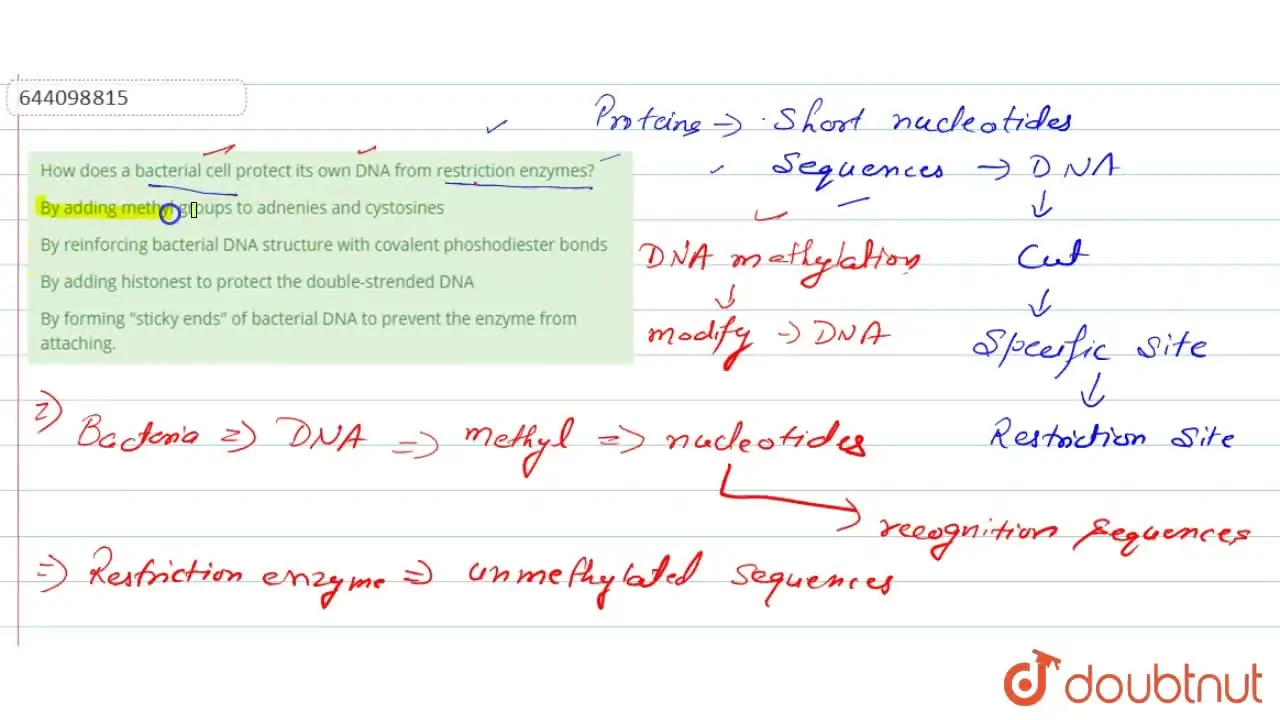How does a bacterial cell protect its own DNA from restriction enzymes?
By adding methyl groups to adnenies and cystosines
By reinforcing bacterial DNA structure with covalent phoshodiester bonds
By adding histonest to protect the double-strended DNA
By forming "sticky ends" of bacterial DNA to prevent the enzyme from attaching.
The correct Answer is:A
Step by step video & image solution for How does a bacterial cell protect its own DNA from restriction enzymes? by Biology experts to help you in doubts & scoring excellent marks in Class 12 exams.
Related Playlists
- BOOK - CENGAGE BIOLOGY ENGLISHCHAPTER - BIOTECHNOLOGY AND ITS APPLICATIONSEXERCISE - EXERCISES (ASSERTION - RESASONING QUESTIONS)5videos
BIOTECHNOLOGY AND ITS APPLICATIONS
- BOOK - CENGAGE BIOLOGY ENGLISHCHAPTER - BIOTECHNOLOGY AND ITS APPLICATIONSEXERCISE - ARCHIVES (CHOOSE THE CORRECT OPTIONS)21videos
BIOTECHNOLOGY AND ITS APPLICATIONS
- BOOK - CENGAGE BIOLOGY ENGLISHCHAPTER - BIODIVERSITY AND CONSERVATION EXERCISE - Archives22videos
BIODIVERSITY AND CONSERVATION
- BOOK - CENGAGE BIOLOGY ENGLISHCHAPTER - BIOTECHNOLOGY:PRINCIPLES AND PROCESSESEXERCISE - ARCHIVES (Choose the correct option)33videos
BIOTECHNOLOGY:PRINCIPLES AND PROCESSES
Similar Questions
How does bacterial DNA is protected against restriction enzymes?
View SolutionHow is bacterial cell different from onion peel?
View SolutionHow does vaccination protect a person from a disease?
View SolutionHow does the human body protect itself from infection?
View SolutionHow long is the recognition sequence of the first restriction enzyme isolated ?
View SolutionAssertion : A bacterial cell with restriction enzymes will be easily infected and lysed by bacteriophages.
Reason : Restriction enzymes catalyse synthesis of protective coat around bacterial cell that prevents bacteriophage attack.View Solution(i) Describe the characteristics a cloning vector must possess. (ii) Why DNA cannot pass through the cell membrane ? Explain. How is a bacterial cell made competent to take up recombinant DNA from the medium?
View SolutionAssertion: Restriction endonucleases produces overhanging stretches called sticky ends on each DNA strand
Reason :Restriction enzymes cut the strand of DNA a little away from the centre of pallindrome sitesView SolutionWhich of the following statements does not hold true for restriction enzyme?
View SolutionKey tools to be involved in recombinant DNA technolgy are
Restriction enzymes
Polymerase enzyme
Ligase enzymes
VectorsView Solution


